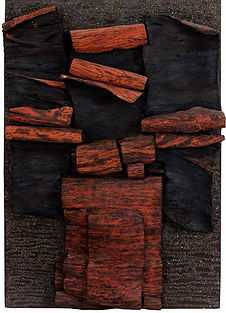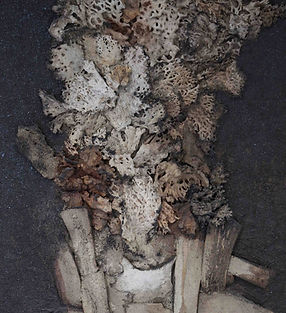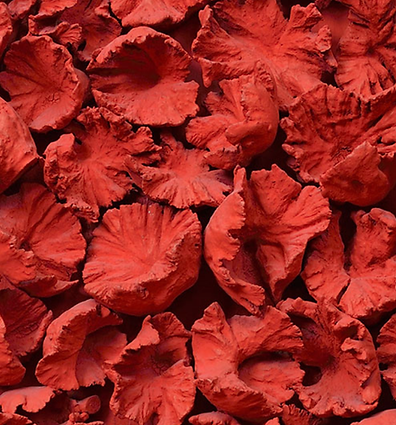%2C%20160%20x%20110%20x%2015%20cm%2C%201991.jpg)

%2C%201990%2C%20Bois%20(Imbauba%20sauvage)%2C%20branches%2C%20colle%20et%20pigments.png)
Tableau-assemblages
Frans Krajcberg’s tableau-assemblages stem from the same approach: to bring the dead back to life. Even the smallest natural detail, often overlooked by the eye, can help us reconnect with nature. Disparate elements gathered from the wild—stones, vines, coral, leaves, wood—become entire universes to which light or the imperceptible movement of an insect restores life.
The red flowers
In the 1960s in Paris, Frans Krajcberg created an initial series of tableau-assemblages made from sculpted flowers, covered with natural red pigments—the color of fire and strength. His approach leaned more toward reproduction than reappropriation. His painted flowers emit a violence that links the force of life—the red—with a symbol of death, for to him, the flower carries something morbid within itself.
Tableau-assemblages of natural fragments
Frans Krajcberg works on his tableau-assemblages made of natural fragments by applying a mixture of earth and glue onto sun-dried paper, on which the elements are then redrawn. He also creates simple collages on wooden panels. His "tableau-assemblages" stage the presented elements, highlighting their natural beauty to develop new forms, new universes, and new messages.
His early stone tableaux reveal the living, vibrant nature of stone without any artifice. Matter and color remain raw. No artwork is made from the same stones twice. He meticulously collects quartz, granite, amethyst, crystals... Transparent or opaque, round or pointed, the stones reveal a world of unparalleled shapes, colors, and unsuspected vibrations.


According to Thérèse Vian, “Krajcberg’s stone tableaux are a silent invitation to endless reverie, a space for reflection that opens onto Nature, onto Man, the visible and the invisible. A reverie of solidity, hardness, and resistance, which, when related to his work, would highlight his painful past, always underlying. This past that never leaves him and which would have made him, seemingly, as hard and sharp as the stone. This desire to evoke cutting images undoubtedly reveals in the artist the need to perform a true surgical operation that would cut into the heart of this painful past. The stone therefore played a liberating role for the artist, who no longer had the same need to use it at the end of his life. It would continue to be present in his later works but no longer as prominently. It would become merely an element of aesthetic ornamentation, embellishing his charred trees.”
“My conclusion is that I am poorer than nature, that she creates much more than I do. I saw in her all the forms we think we invent, and we invent nothing. I wanted to dominate her. I made paintings with stones in Minas Gerais and I saw that in nature itself they were much more expressive, much more alive than the paintings I had made, so I gave up,” Frans Krajcberg.
